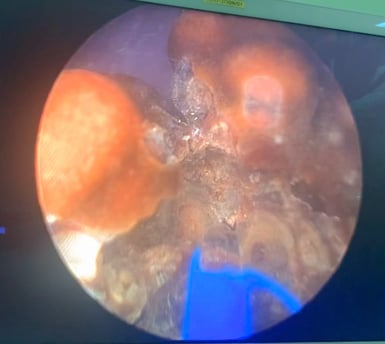Kidney stone treatment by urologist: update
Breaking Ground: Kidney stone treatment by urologist: update Urinary stones, often referred to as kidney stones, can cause excruciating pain and discomfort for those who suffer from them. Fortunately, advancements in medical technology and treatment options are revolutionising the management and treatment of urinary stones, offering hope and relief to millions of patients worldwide. Let's delve into some of the recent breakthroughs in urinary stones treatment that are shaping the landscape of urology. 1. Minimally Invasive Procedures Traditionally, the treatment of urinary stones involved invasive surgical procedures such as open surgery or shock wave lithotripsy (SWL). However, recent advancements have ushered in a new era of minimally invasive procedures that offer less pain, faster recovery times, and reduced risk of complications. 2. Laser Lithotripsy One of the most significant advancements in urinary stones treatment is the widespread adoption of laser lithotripsy. This minimally invasive procedure involves using a laser to break down kidney stones into smaller fragments, which are then easily passed through the urinary tract. Laser lithotripsy is highly effective for treating stones of varying sizes and compositions, with minimal risk to surrounding tissues. 3. Ureteroscopy Ureteroscopy is another minimally invasive procedure that has become increasingly popular for the treatment of urinary stones. During ureteroscopy, a thin, flexible tube equipped with a camera and small instruments is inserted into the urinary tract to locate and remove stones. This technique allows for precise targeting of stones and can be performed on an outpatient basis with minimal discomfort to the patient. 4. Percutaneous Nephrolithotomy (PCNL) For larger or more complex kidney stones, percutaneous nephrolithotomy (PCNL) offers an effective treatment option. In this procedure, a small incision is made in the back, and a nephroscope is inserted directly into the kidney to remove stones. PCNL is particularly beneficial for patients with large stones or anatomical abnormalities that may complicate other treatment methods. 5. Advances in Imaging Technology Accurate diagnosis and localization of urinary stones are critical for effective treatment planning. Recent advancements in imaging technology, such as computed tomography (CT) scans and ultrasound, allow urologists to precisely visualize the size, location, and composition of stones. This enables tailored treatment approaches that optimize outcomes while minimizing risks and complications. 6. Preventive Strategies In addition to innovative treatment modalities, there is a growing emphasis on preventive strategies for urinary stone formation. This includes dietary modifications, hydration therapy, and the use of medications to manage underlying metabolic abnormalities that contribute to stone formation. By addressing underlying risk factors, patients can reduce the likelihood of recurrent stone episodes and improve long-term urinary health. In conclusion, the field of urinary stones treatment is experiencing rapid advancements, driven by innovations in technology, surgical techniques, and preventive strategies. These advancements are reshaping the way urologists approach the diagnosis, management, and treatment of urinary stones, ultimately leading to improved outcomes and quality of life for patients. As researchers continue to push the boundaries of medical science, the future holds even greater promise for those affected by urinary stones.


The Latest Advancements in Urinary (Kidney) Stones Treatment
Urinary stones, often referred to as kidney stones, can cause excruciating pain and discomfort for those who suffer from them. Fortunately, advancements in medical technology and treatment options are revolutionising the management and treatment of urinary stones, offering hope and relief to millions of patients worldwide. Let's delve into some of the recent breakthroughs in urinary stones treatment that are shaping the landscape of urology.
1. Minimally Invasive Procedures
Traditionally, the treatment of urinary stones involved invasive surgical procedures such as open surgery or shock wave lithotripsy (SWL). However, recent advancements have ushered in a new era of minimally invasive procedures that offer less pain, faster recovery times, and reduced risk of complications.
2. Laser Lithotripsy
One of the most significant advancements in urinary stones treatment is the widespread adoption of laser lithotripsy. This minimally invasive procedure involves using a laser to break down kidney stones into smaller fragments, which are then easily passed through the urinary tract. Laser lithotripsy is highly effective for treating stones of varying sizes and compositions, with minimal risk to surrounding tissues.
3. Ureteroscopy
Ureteroscopy is another minimally invasive procedure that has become increasingly popular for the treatment of urinary stones. During ureteroscopy, a thin, flexible tube equipped with a camera and small instruments is inserted into the urinary tract to locate and remove stones. This technique allows for precise targeting of stones and can be performed on an outpatient basis with minimal discomfort to the patient.
4. Percutaneous Nephrolithotomy (PCNL)
For larger or more complex kidney stones, percutaneous nephrolithotomy (PCNL) offers an effective treatment option. In this procedure, a small incision is made in the back, and a nephroscope is inserted directly into the kidney to remove stones. PCNL is particularly beneficial for patients with large stones or anatomical abnormalities that may complicate other treatment methods.
5. Advances in Imaging Technology
Accurate diagnosis and localization of urinary stones are critical for effective treatment planning. Recent advancements in imaging technology, such as computed tomography (CT) scans and ultrasound, allow urologists to precisely visualize the size, location, and composition of stones. This enables tailored treatment approaches that optimize outcomes while minimizing risks and complications.
6. Preventive Strategies
In addition to innovative treatment modalities, there is a growing emphasis on preventive strategies for urinary stone formation. This includes dietary modifications, hydration therapy, and the use of medications to manage underlying metabolic abnormalities that contribute to stone formation. By addressing underlying risk factors, patients can reduce the likelihood of recurrent stone episodes and improve long-term urinary health.
In conclusion, the field of urinary stones treatment is experiencing rapid advancements, driven by innovations in technology, surgical techniques, and preventive strategies. These advancements are reshaping the way urologists approach the diagnosis, management, and treatment of urinary stones, ultimately leading to improved outcomes and quality of life for patients. As researchers continue to push the boundaries of medical science, the future holds even greater promise for those affected by urinary stones.
